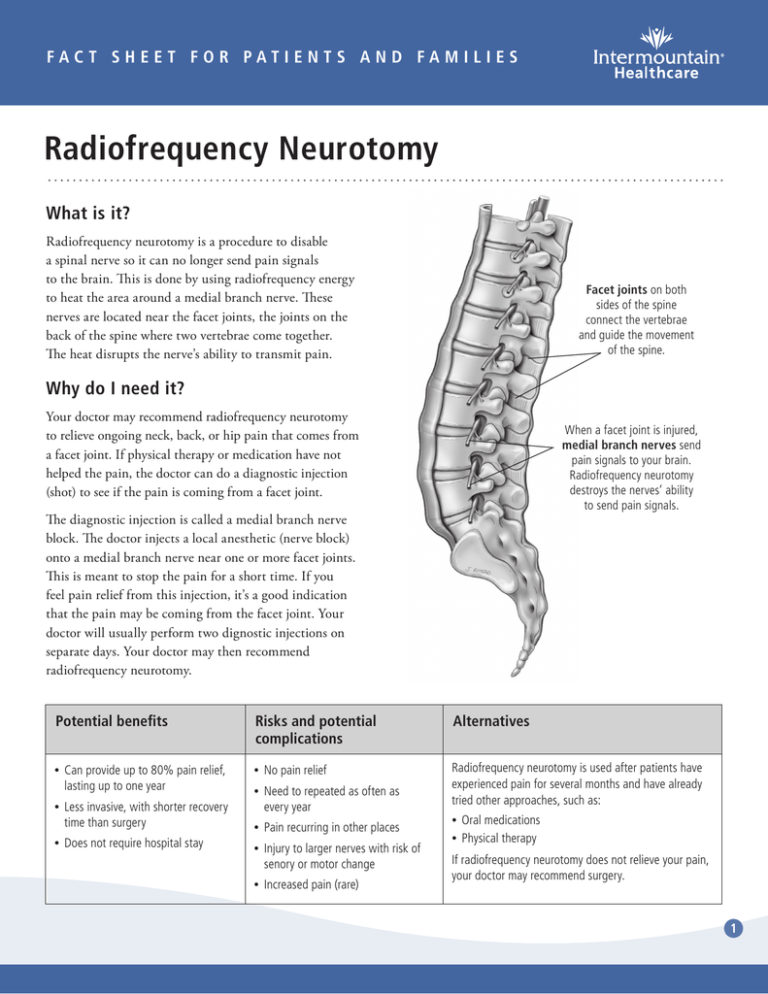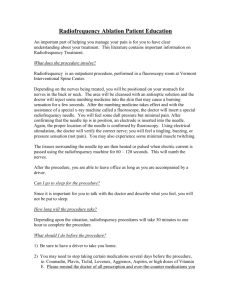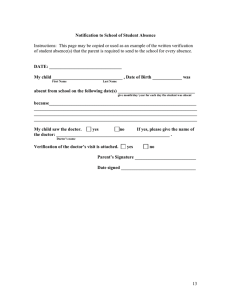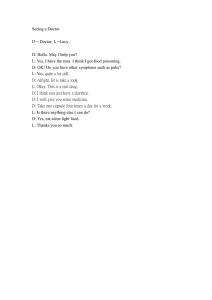
FACT SHEET FOR PATIENTS AND FAMILIES
Radiofrequency Neurotomy
What is it?
Radiofrequency neurotomy is a procedure to disable
a spinal nerve so it can no longer send pain signals
to the brain. This is done by using radiofrequency energy
to heat the area around a medial branch nerve. These
nerves are located near the facet joints, the joints on the
back of the spine where two vertebrae come together.
The heat disrupts the nerve’s ability to transmit pain.
Facet joints on both
sides of the spine
connect the vertebrae
and guide the movement
of the spine.
Why do I need it?
Your doctor may recommend radiofrequency neurotomy
to relieve ongoing neck, back, or hip pain that comes from
a facet joint. If physical therapy or medication have not
helped the pain, the doctor can do a diagnostic injection
(shot) to see if the pain is coming from a facet joint.
When a facet joint is injured,
medial branch nerves send
pain signals to your brain.
Radiofrequency neurotomy
destroys the nerves’ ability
to send pain signals.
The diagnostic injection is called a medial branch nerve
block. The doctor injects a local anesthetic (nerve block)
onto a medial branch nerve near one or more facet joints.
This is meant to stop the pain for a short time. If you
feel pain relief from this injection, it’s a good indication
that the pain may be coming from the facet joint. Your
doctor will usually perform two dignostic injections on
separate days. Your doctor may then recommend
radiofrequency neurotomy.
Potential benefits
Risks and potential
complications
Alternatives
•• Can provide up to 80% pain relief,
lasting up to one year
•• No pain relief
Radiofrequency neurotomy is used after patients have
experienced pain for several months and have already
tried other approaches, such as:
•• Less invasive, with shorter recovery
time than surgery
•• Does not require hospital stay
•• Need to repeated as often as
every year
•• Pain recurring in other places
•• Injury to larger nerves with risk of
senory or motor change
•• Increased pain (rare)
•• Oral medications
•• Physical therapy
If radiofrequency neurotomy does not relieve your pain,
your doctor may recommend surgery.
1
How do I prepare for the procedure?
What happens after?
There are a few things you can do to make the
procedure go better:
•• You may have your vital signs (heart rate, blood
pressure, breathing rate) monitored for up to 30
minutes after the injection.
•• Medication changes. You may be asked to stop or
change the dose of certain medications for several days
before the procedure. Always ask your doctor before
stopping any medications.
•• Medication list. Bring a list of all your current
medications to the hospital. Be sure to mention
everything, including over-the-counter medications
and vitamins.
•• Food and drink. Do not eat or drink for 6 to 8 hours
before the procedure.
What happens during?
You will remain awake during the procedure. This will
allow you to tell the doctor when you feel the pain go
away. Your procedure will include the following:
•• Position. You will lie face down on an operating table.
•• Sedative. You may be given a mild sedative to help
you relax.
•• Local Anesthetic. You will be given a local anesthetic
to numb your skin near the injection site.
•• Positioning the needle. Your doctor will insert a
thin needle near the facet joint that is causing the pain,
using an x-ray to help position the needle in the best
place. Each joint has two medial branch nerves, so each
joint treated will have two needle positions.
•• Initial electric pulse. Your doctor will insert an
electrode through the needle and send a weak electric
pulse. This will help your doctor know if the needle is
in the best position. You may feel some twitching. Your
doctor may ask you questions about what you feel that
will also help position the needle.
•• Pain medication. Your doctor will inject more pain
medication close to the nerves being treated to help
with any discomfort.
•• You will not be allowed to drive home. Someone will
need to drive you.
•• You may feel sore from the injection for 1 to 4 days.
•• Your back may feel numb, weak, or itchy for a couple
of weeks.
•• Your pain may flare up and feel worse for a few days
before it starts to feel better. It may take 3 to 4 weeks
to feel the full pain relief of the neurotomy.
•• Be SURE to follow up with your doctor in one to
two weeks. Your doctor needs to know how well the
procedure worked and if you need additional treatment.
When will I feel relief — and how long
will it last?
About half of people who have radiofrequecy neurotomy
feel pain relief, and it can take up to 4 weeks to feel it.
The pain relief should last 6 to 16 months. After that, the
treated nerves can begin to grow back, and the pain may
or may not return. If the pain does return, physical
therapy and greater muscle strength around the joint may
make it less than it was before the procedure. If necessary,
another radiofrequency neurotomy can be done.
When should I call the doctor?
Once you go home, you should gradually start to feel
better. Call your doctor if you’re concerned about your
progress, or if you have any of these symptoms:
•• Severe back pain
•• Fever or chills
•• Increase in pain that is not getting better within
two weeks
•• Radiofrequency pulse. Your doctor will use
radiofrequency energy to disable the medial branch nerve.
The procedure will be repeated at each needle position.
© 2008 -2011 Intermountain Healthcare. All rights reserved. The content presented here is for your information only. It is not a substitute for professional medical advice, and
it should not be used to diagnose or treat a health problem or disease. Please consult your healthcare provider if you have any questions or concerns. More health information is
available at intermountainhealthcare.org. Patient and Provider Publications 801-442-2963 FS020 - 01/11 Also available in Spanish.
2






